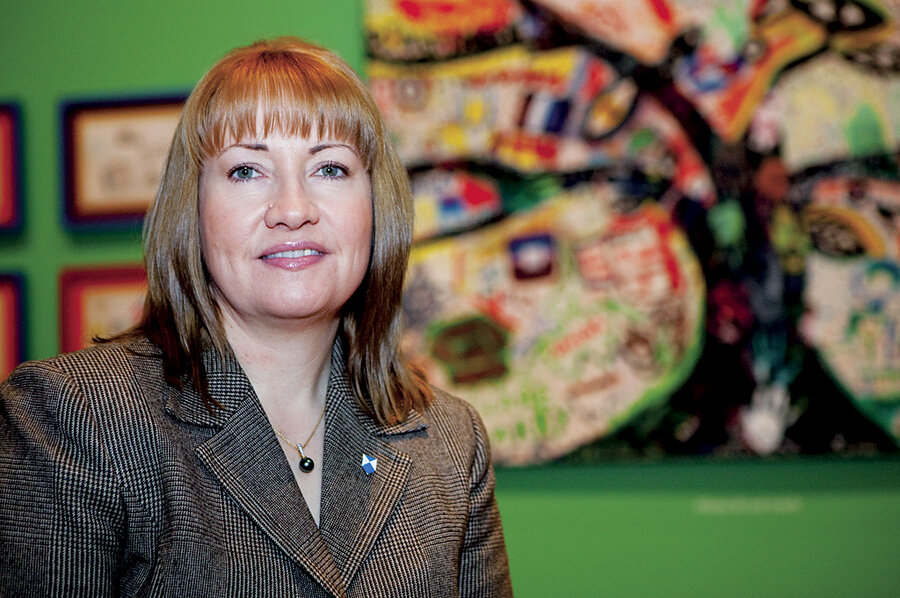After the Haitian earthquake: saving priceless murals, artifacts, and other treasures
Loading...
| Port-au-Prince, Haiti
Cori Wegener, an associate curator at the Minneapolis Institute of Arts, talks of missions to rescue works of art and other "cultural property" in the wake of disasters as if they were warfare.
She speaks of SWAT teams and military missions and emergency situations. And she knows what she is talking about.
Ms. Wegener, a combat veteran, has literally written the book on rescuing cultural treasures: a US Army training manual with the daunting title "GTA 41-01-002: Arts, Monuments, and Archives Guide." It refers to a country's churches, mosques, temples, museums, works of art, and archives as "its soul, its memory, and its meaning."
Yet too often, she says, outright plunder has followed an armed conflict or natural catastrophe such as an earthquake, leaving a country in danger of losing the "tangible representation of significant human events, beliefs, and values."
Now Wegener, a retired Army major, is doing something about it.
Her thinking on the issue, she says, is being shaped by her work as the international project coordinator of the Smithsonian Institution's Haiti Cultural Recovery Project – created largely at her initiative following the earthquake that struck that Caribbean island last year.
The project, whose aim is to recover, safeguard, and help restore Haitian works of art, artifacts, documents, and other cultural property, is being overseen by Richard Kurin, the Smithsonian's undersecretary for history, art, and culture.
But it was Wegener, Dr. Kurin says, who provided the spark for the project by calling a meeting of art professionals and US government officials less than a month after the Haitian earthquake to discuss what they could do to help.
The group decided to supplement the humanitarian aid going into Haiti with an aggressive program of "cultural aid."
An initial $275,000 was provided by The Broadway League, a national trade association of US commercial theaters. Another $90,000 was provided by the National Endowment for the Arts, the Endowment for the Humanities, and the Institute for Museums and Library Science.
Then the United States Agency for International Development set aside another $2 million for the project. Private donors, notably Broadway producer Margo Lion, also stepped in with support.
Under an agreement with the Haitian government, work on the project will run through November. After that, it will be turned over to the Haitian people, Wegener says in an interview.
Central to the project will be the removal, repair, and safe storage of three huge murals at the Holy Trinity Episcopal Cathedral in downtown Port-au-Prince, the capital. They somehow survived the earthquake, which nearly leveled the church.
The murals were painted in the late 1940s and early '50s by three of Haiti's most famous artists: Philomé Obin ("The Last Supper"), Castera Bazile ("Baptism of Our Lord"), and Préfète Duffaut ("Native Street Procession"). Eleven other murals in the church were damaged beyond repair.
Work on removing the murals for eventual installation in a new church began in January and is expected to take another two months or so. The restoration work will be carried out at a three-story building in the hills overlooking Port-au-Prince previously occupied by the United Nations Development Program and now dubbed the Haiti Cultural Recovery Center.
Stephanie Hornbeck, a retired Smithsonian conservator who is serving as chief conservator for the project, told a recent visitor to the center that tens of thousands of objects rescued from the quake need to be restored. These include thousands of paintings and sculptures from the Musée d'Art Nader in Pétionville, a private museum that housed works by 20th-century Haitian masters such as Duffaut and Hector Hyppolite.
Also flattened in the earthquake was the Centre d'Art, where many of those same masters were trained and which contained thousands of paintings now in need of restoration.
Wegener is also president of the US Committee of the Blue Shield, which considers itself the cultural equivalent of the Red Cross. It provides assistance to countries whose cultural heritage has been threatened by disaster.
She was deployed to Iraq in 2003 to help revive the National Museum and saw there firsthand how a quicker response could have saved much more art. She's determined to see that that will not happen in Haiti.
"What we're talking about is an emergency response to a cultural disaster," Wegener says. She hopes to put together an international institution to save works of art modeled on Doctors Without Borders that would be ready – bags packed and money in the bank – to move out at a moment's notice, she says.
"We want to be able to respond quickly to the next disaster," she says. "We're working toward that goal."
It is shortsighted to focus only on providing humanitarian assistance while ignoring the need to also restore a nation's cultural heritage, she says.
"Clearly, it is an essential part of any country's overall recovery," she says.
• To see other stories about people making a difference, go here.





